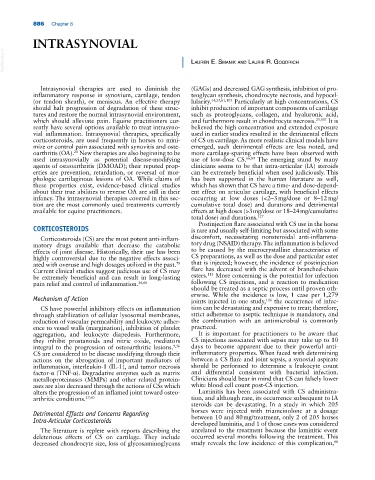Page 920 - Adams and Stashak's Lameness in Horses, 7th Edition
P. 920
886 Chapter 8
INTRASYNOVIAL
VetBooks.ir Lauren e. SmaniK anD Laurie r. GooDrich
Intrasynovial therapies are used to diminish the (GAGs) and decreased GAG synthesis, inhibition of pro-
inflammatory response in synovium, cartilage, tendon teoglycan synthesis, chondrocyte necrosis, and hypocel-
(or tendon sheath), or meniscus. An effective therapy lularity. 14,25,61,103 Particularly at high concentrations, CS
should halt progression of degradation of these struc- inhibit production of important components of cartilage
tures and restore the normal intrasynovial environment, such as proteoglycans, collagen, and hyaluronic acid,
which should alleviate pain. Equine practitioners cur- and furthermore result in chondrocyte necrosis. 25,111 It is
rently have several options available to treat intrasyno- believed the high concentration and extended exposure
vial inflammation. Intrasynovial therapies, specifically used in earlier studies resulted in the detrimental effects
corticosteroids, are used frequently in horses to mini- of CS on cartilage. As more realistic clinical models have
mize or control pain associated with synovitis and oste- emerged, such detrimental effects are less noted, and
oarthritis (OA). New therapies are also beginning to be more cartilage‐sparing effects have been observed with
20
used intrasynovially as potential disease‐modifying use of low‐dose CS. 66,89 The emerging stand by many
agents of osteoarthritis (DMOAD); their reputed prop- clinicians seems to be that intra‐articular (IA) steroids
erties are prevention, retardation, or reversal of mor- can be extremely beneficial when used judiciously. This
phologic cartilaginous lesions of OA. While claims of has been supported in the human literature as well,
these properties exist, evidence‐based clinical studies which has shown that CS have a time‐ and dose‐depend-
about their true abilities to reverse OA are still in their ent effect on articular cartilage, with beneficial effects
infancy. The intrasynovial therapies covered in this sec- occurring at low doses (<2–3 mg/dose or 8–12 mg/
tion are the most commonly used treatments currently cumulative total dose) and durations and detrimental
available for equine practitioners. effects at high doses (>3 mg/dose or 18–24 mg/cumulative
total dose) and durations. 117
Postinjection flare associated with CS use in the horse
CORTICOSTEROIDS is rare and usually self‐limiting but associated with some
Corticosteroids (CS) are the most potent anti‐inflam- discomfort, necessitating nonsteroidal anti‐inflamma-
matory drugs available that decrease the catabolic tory drug (NSAID) therapy. The inflammation is believed
effects of joint disease. Historically, their use has been to be caused by the microcrystalline characteristics of
highly controversial due to the negative effects associ- CS preparations, as well as the dose and particular ester
ated with overuse and high dosages utilized in the past. that is injected; however, the incidence of postinjection
78
Current clinical studies suggest judicious use of CS may flare has decreased with the advent of branched‐chain
113
be extremely beneficial and can result in long‐lasting esters. More concerning is the potential for infection
pain relief and control of inflammation. 36,66 following CS injections, and a reaction to medication
should be treated as a septic process until proven oth-
erwise. While the incidence is low, 1 case per 1,279
Mechanism of Action joints injected in one study, the occurrence of infec-
106
CS have powerful inhibitory effects on inflammation tion can be devastating and expensive to treat; therefore,
through stabilization of cellular lysosomal membranes, strict adherence to aseptic technique is mandatory, and
reduction of vascular permeability and leukocyte adher- the combination with an antimicrobial is commonly
ence to vessel walls (margination), inhibition of platelet practiced.
aggregation, and leukocyte diapedesis. Furthermore, It is important for practitioners to be aware that
they inhibit prostanoids and nitric oxide, mediators CS injections associated with sepsis may take up to 10
integral to the progression of osteoarthritic lesions. 9,56 days to become apparent due to their powerful anti-
CS are considered to be disease modifying through their inflammatory properties. When faced with determining
actions on the abrogation of important mediators of between a CS flare and joint sepsis, a synovial aspirate
inflammation, interleukin‐1 (IL‐1), and tumor necrosis should be performed to determine a leukocyte count
factor‐α (TNF‐α). Degradative enzymes such as matrix and differential consistent with bacterial infection.
metalloproteinases (MMPs) and other related protein- Clinicians should bear in mind that CS can falsely lower
ases are also decreased through the actions of CSs which white blood cell count post‐CS injection.
alters the progression of an inflamed joint toward osteo- Laminitis has been associated with CS administra-
arthritic conditions. 27,60 tion, and although rare, its occurrence subsequent to IA
steroids can be devastating. In a study in which 205
Detrimental Effects and Concerns Regarding horses were injected with triamcinolone at a dosage
between 10 and 80 mg/treatment, only 2 of 205 horses
Intra‐Articular Corticosteroids developed laminitis, and 1 of those cases was considered
The literature is replete with reports describing the unrelated to the treatment because the laminitic event
deleterious effects of CS on cartilage. They include occurred several months following the treatment. This
80
decreased chondrocyte size, loss of glycosaminoglycans study reveals the low incidence of this complication,

